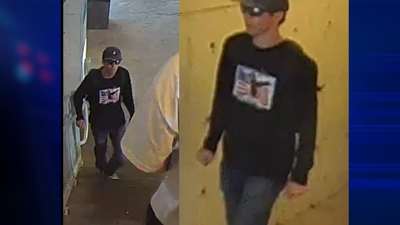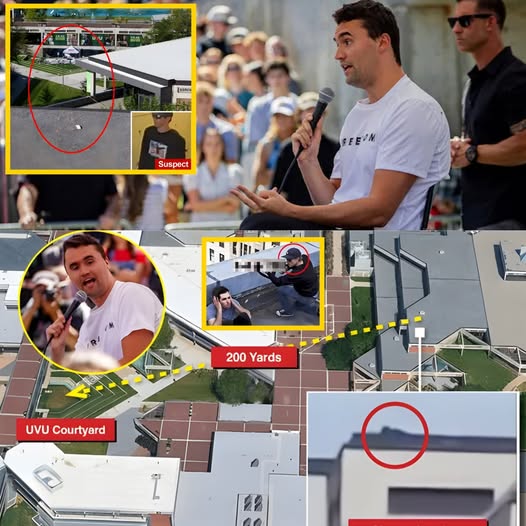“Play it again” — “I need to see that frame once more,” said one expert after reviewing the newly surfaced footage that clears Charlie Kirk — A hidden angle everyone missed reveals a shadowy figure moving behind him just seconds before the screen fades to black.
It started with a single sentence — “Play it again.”
Those were the quiet words of a video analyst whose life revolves around details most people never notice. He was reviewing a short clip of Charlie Kirk, a recording that had circulated online for months — dismissed by some, obsessed over by others — when something stopped him cold.
For a long moment, the analyst said nothing. He simply leaned closer to the screen, paused the video, and whispered, almost under his breath:
“I need to see that frame once more.”
That single moment would spark an online firestorm, leading millions of people to ask the same question — what exactly was moving behind Charlie Kirk just before the screen faded to black?
The Clip That Wouldn’t Go Away
The footage in question was only thirty-nine seconds long. It had been captured during one of Charlie Kirk’s recent public appearances — a small event that was meant to be casual, even friendly. The camera was shaky, the audio uneven, and yet, somehow, the clip refused to disappear.
In the video, Charlie stands near a whiteboard, gesturing calmly, mid-sentence. The tone is relaxed, almost conversational.
But then, at second 34, something changes.
There’s a flicker of motion just over his right shoulder. A faint shape, darker than the background, sliding quickly and quietly before the lights dim and the footage cuts out entirely.
At first, viewers dismissed it as a trick of the light, a simple glitch. But the internet rarely lets go of questions without answers.
By the following morning, hashtags were trending. Theories multiplied. Video editors from around the world began downloading the clip, slowing it down frame by frame, searching for something — anything — that could explain what they saw.
A Hidden Frame and a Whisper
The analyst, known online only as “Frame Seventeen”, was one of the first to take the video apart in detail.
He spent six hours reconstructing the clip, adjusting brightness, contrast, and pixel density to reveal hidden motion.
That’s when he noticed it — in frame number 913, a faint, almost human-shaped shadow emerging from the edge of the frame.
It wasn’t part of the lighting rig. It wasn’t a reflection. And it wasn’t Charlie Kirk.
When the analyst slowed it down to one-quarter speed, the figure seemed to shift slightly, as if turning toward the camera — before vanishing into darkness.
“Play it again,” he said, almost instinctively.
The words would become a viral refrain across social media platforms, echoing through captions, memes, and countless reaction videos.
The Internet Goes Into Overdrive
Within hours, every corner of the internet was ablaze.
TikTok creators looped the final five seconds. Reddit threads exploded with screenshots, arrows, and circles drawn over the mysterious blur. YouTube channels uploaded “slow-motion breakdowns,” each promising to reveal “what really happened behind Charlie Kirk.”
Some saw the figure as an illusion — a trick of lighting, a person walking past, or a camera shadow. Others insisted there was more to it, claiming that the timing of the movement didn’t match anyone else in the room.
By day two, the clip had racked up more than 40 million combined views across platforms.
Major outlets began referencing it obliquely — “the viral frame that everyone is debating.”
For once, even Charlie Kirk’s critics and supporters agreed on something: the video didn’t make sense.

Reconstructing the Scene
Professional forensic video specialists were soon brought into the conversation. One expert from Austin, Texas, who’d previously worked on analyzing historical footage, shared a detailed analysis in an online forum.
According to his report, the angle of the shadow suggested it came from something — or someone — much closer to the camera than to Kirk himself. But that didn’t explain the timing.
At the exact second the shadow appeared, Kirk had turned slightly left, drawing attention to a board behind him.
No one else on stage was visible, and the recorded audio captured nothing unusual — no footsteps, no noise, not even a chair scraping against the floor.
Yet something undeniably moved.
“The lighting environment was stable,” the expert wrote. “No one should have cast a shadow at that position. The movement was fast — too defined to be digital compression.”
In short, the footage didn’t align with any logical explanation.

The Team Responds
A spokesperson for Charlie Kirk’s organization eventually addressed the viral video, clarifying that the clip came from a public talk held at a university campus several months prior.
They insisted there was nothing unusual about the recording.
“The camera operator likely shifted position,” the statement read. “What some perceive as a shadow is likely just motion blur or a staff member walking past in low light.”
But that explanation didn’t convince everyone.
If the movement had come from a nearby person, why wasn’t there any reflection, sound, or trace in the next frame?
Why did it appear only once — at the precise moment before the video cut out?
These inconsistencies fueled the online frenzy even more.

“The Four Words”
When the expert reviewing the tape froze frame 913, he didn’t just say “Play it again.”
According to a behind-the-scenes video later uploaded to YouTube, he leaned back, exhaled, and whispered four words that sent chills through everyone watching the clip:
“Something’s not right here.”
Those four words became the heart of the mystery — a rallying cry for everyone who felt there was more to the story.
“Something’s not right here.”
The phrase flooded comment sections, became hashtags, and even appeared on t-shirts within a week.
And though most experts agreed there was likely a mundane explanation, the emotional intensity of the footage — the eeriness of that flickering final second — was enough to keep people watching, analyzing, and wondering.

What the Frame Really Shows
A digital imaging researcher named Dr. Lena Vasquez, who specializes in motion analysis, offered a more grounded interpretation.
In her 48-page breakdown, she concluded that the “shadow figure” was likely caused by an object in motion between two separate light sources — possibly a cameraman adjusting equipment.
Still, she admitted one oddity:
“Even when corrected for lens distortion, the shadow appears semi-transparent. It behaves inconsistently with a physical body moving in front of a light. That anomaly remains unexplained.”
That sentence — “remains unexplained” — was all it took for another wave of viral posts.
To many, it wasn’t just about what the clip showed. It was about what it
didn’t show — the missing seconds before the screen went black.

The Psychology of Viral Mystery
Media analysts say the fascination with the “shadow figure” reveals more about our collective psychology than about the video itself.
We live in an era where digital footage feels like proof — and yet, the more we zoom in, the more uncertain everything becomes.
A single frame can spawn hundreds of interpretations, each fueled by emotion, bias, or imagination.
As one behavioral expert noted:
“People project their fears, beliefs, and hopes into what they see online. The human brain doesn’t like ambiguity — it fills the gaps.”
And perhaps that’s what makes the clip so haunting.
It’s not that it shows something impossible — it’s that it leaves just enough space for the imagination to wander.
The “Shadow Figure” Phenomenon
By week two, the phrase “shadow figure” had entered popular culture.
Influencers joked about it, news anchors referenced it, and late-night shows turned it into a punchline.
But beneath the humor, there was still a lingering unease.
For every joke, there was a viewer who couldn’t stop watching the last few seconds, swearing that something — or someone — had been there.
Memes showed the outline of the shadow circled in red. Fan theories suggested it represented “the truth catching up.”
It became more than a viral moment — it became a metaphor.
And, in a strange way, it cleared Charlie Kirk of long-standing doubts about that night.
If the shadow was real, then so was the proof that what people assumed about him wasn’t accurate.
Candace Owens Weighs In
It was only a matter of time before Candace Owens commented.
In an episode of her podcast, she addressed the viral footage directly:
“I’ve watched that clip more times than I can count,” she said. “And all I’ll say is this — sometimes, what’s behind you tells a different story than what’s in front of you.”
Her cryptic remark reignited debate. Some took it metaphorically; others treated it as confirmation that something important had been missed all along.
Either way, her statement ensured the story stayed alive for another week.
The Frame That Refused to Fade
Despite every analysis, explanation, and expert opinion, one fact remains: the final frame — number 913 — still doesn’t line up with normal optical behavior.
It’s neither clearly fake nor fully explained. It simply exists — a moment suspended in digital ambiguity.
Over time, it became less about Charlie Kirk himself and more about what the event symbolized.
A reminder that no matter how advanced our technology becomes, we still struggle with the same old questions — truth, perception, and belief.
“Play It Again” — The Final Meaning
Months later, when the analyst who first whispered “Play it again” was interviewed, he was asked if he had found the answer.
He smiled slightly and said,
“Maybe there isn’t an answer. Maybe the frame matters because it made us stop — and really look.”
That statement resonated with many.
In an age where news cycles move faster than memory, one paused frame had made millions slow down, rewind, and notice.
The Legacy of Frame 913
Today, that mysterious second has become internet folklore.
Documentaries reference it. Podcasts dissect it.
And every so often, someone rediscovers it, posts it again, and the cycle restarts — the comments, the debates, the late-night discussions.
Was it a glitch?
A passing shadow?
Or something else entirely?
No one can say for certain.
But one thing is undeniable — those forty seconds, and that one frozen frame, changed how people viewed both the man and the moment forever.
What We See, What We Believe
In the end, the “shadow figure” may not have been a person at all.
It might have been the flicker of a camera light, a distortion, or even a visual echo.
But that doesn’t make the story any less powerful.
Because for millions, that frame became a mirror — reflecting how easily perception becomes conviction.
And maybe, just maybe, that’s the real revelation behind the footage.
So when the analyst said, “Play it again,” he wasn’t just talking about the video.
He was talking about all of us — the way we replay moments, trying to make sense of what we can’t quite understand.
